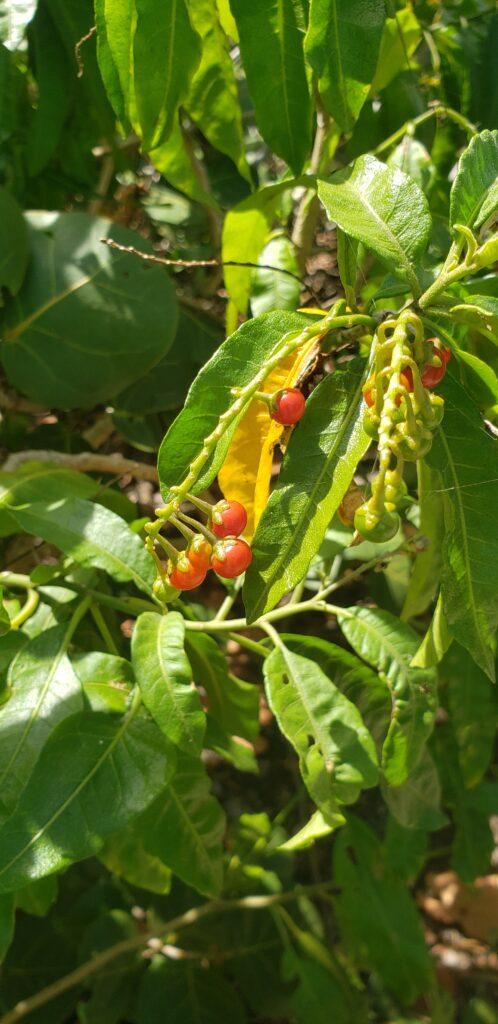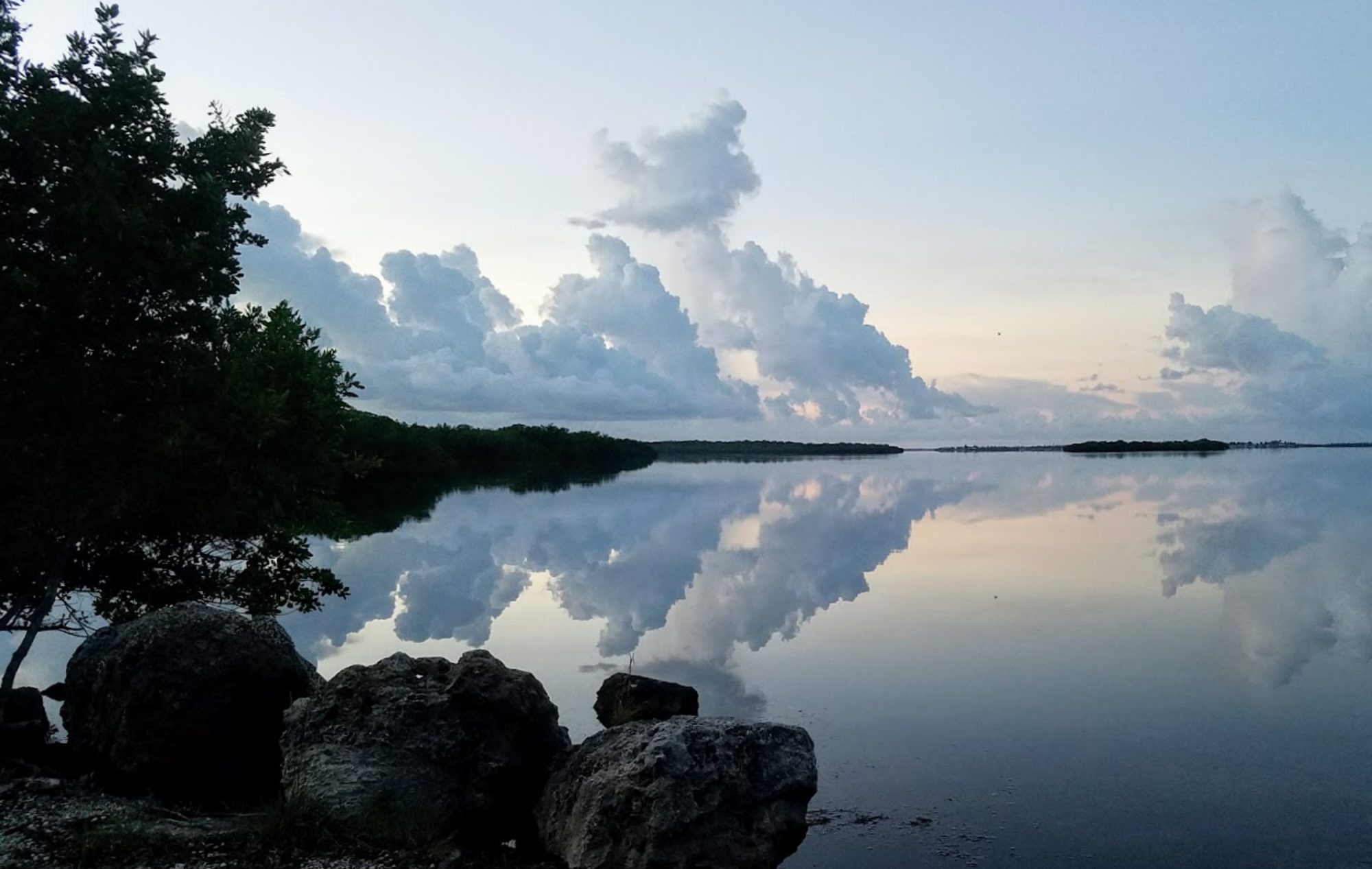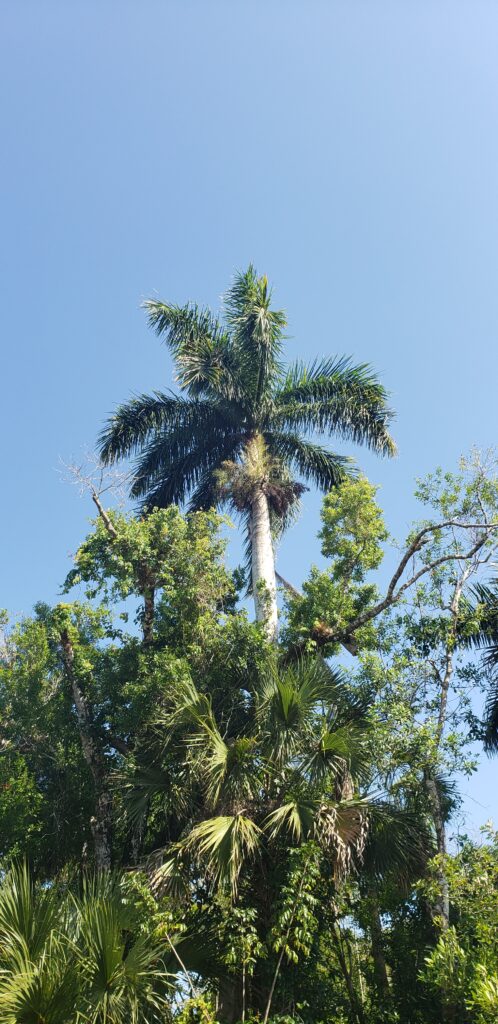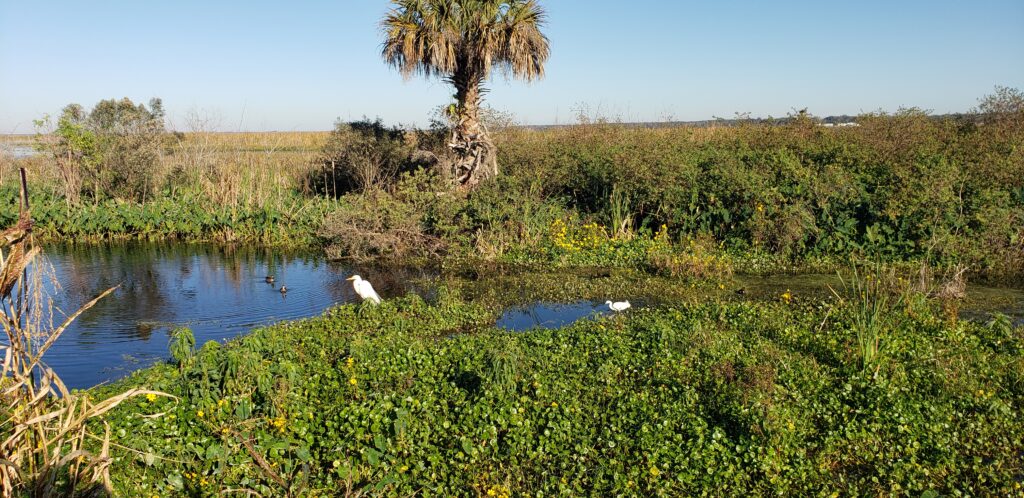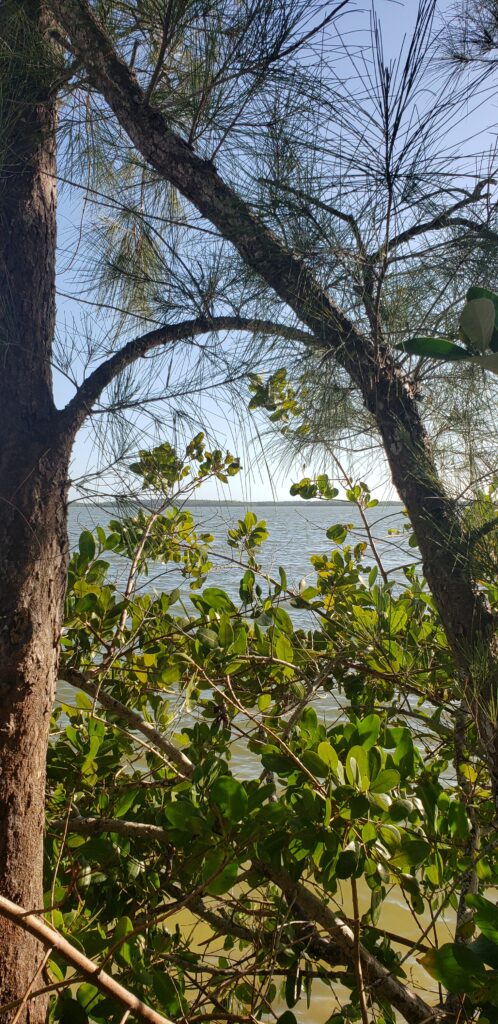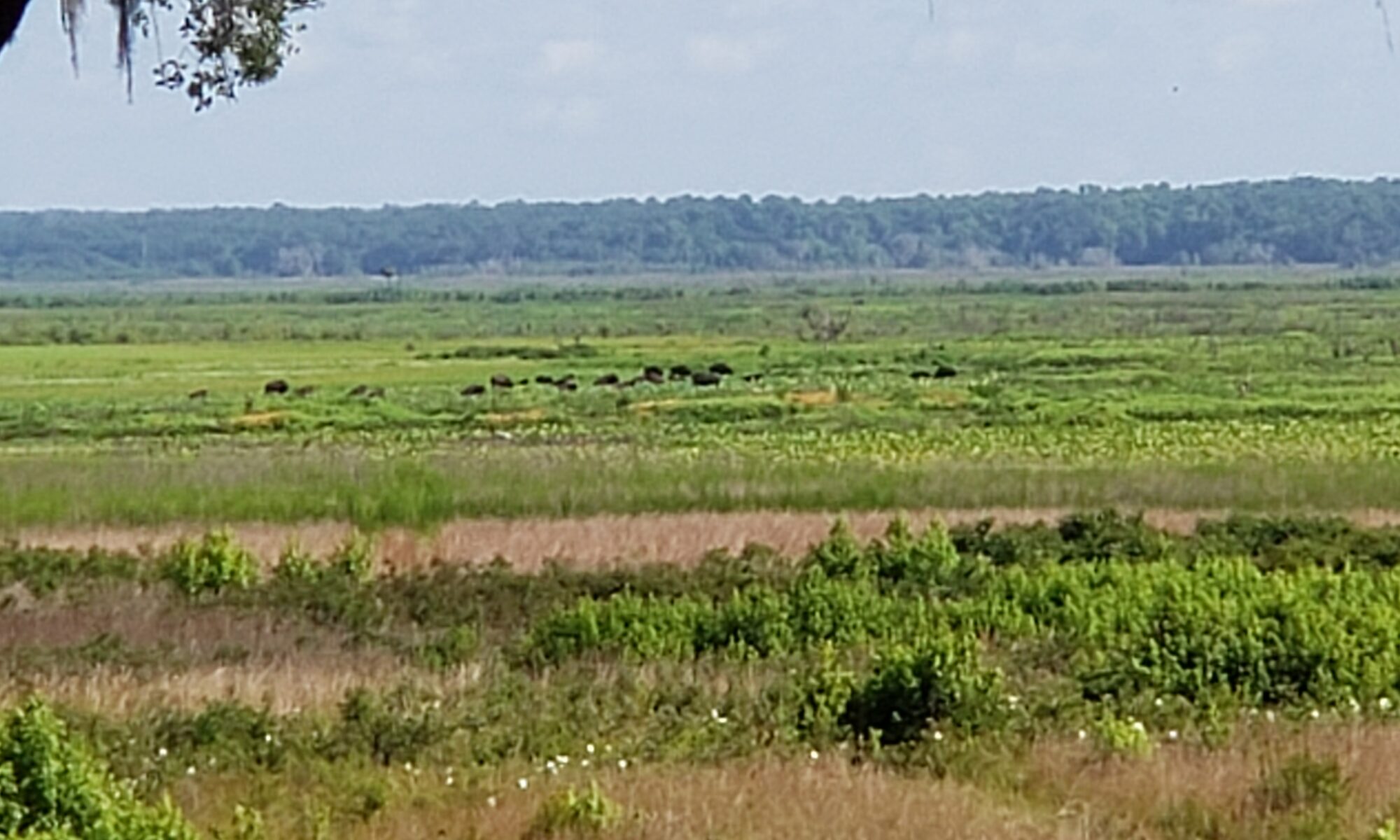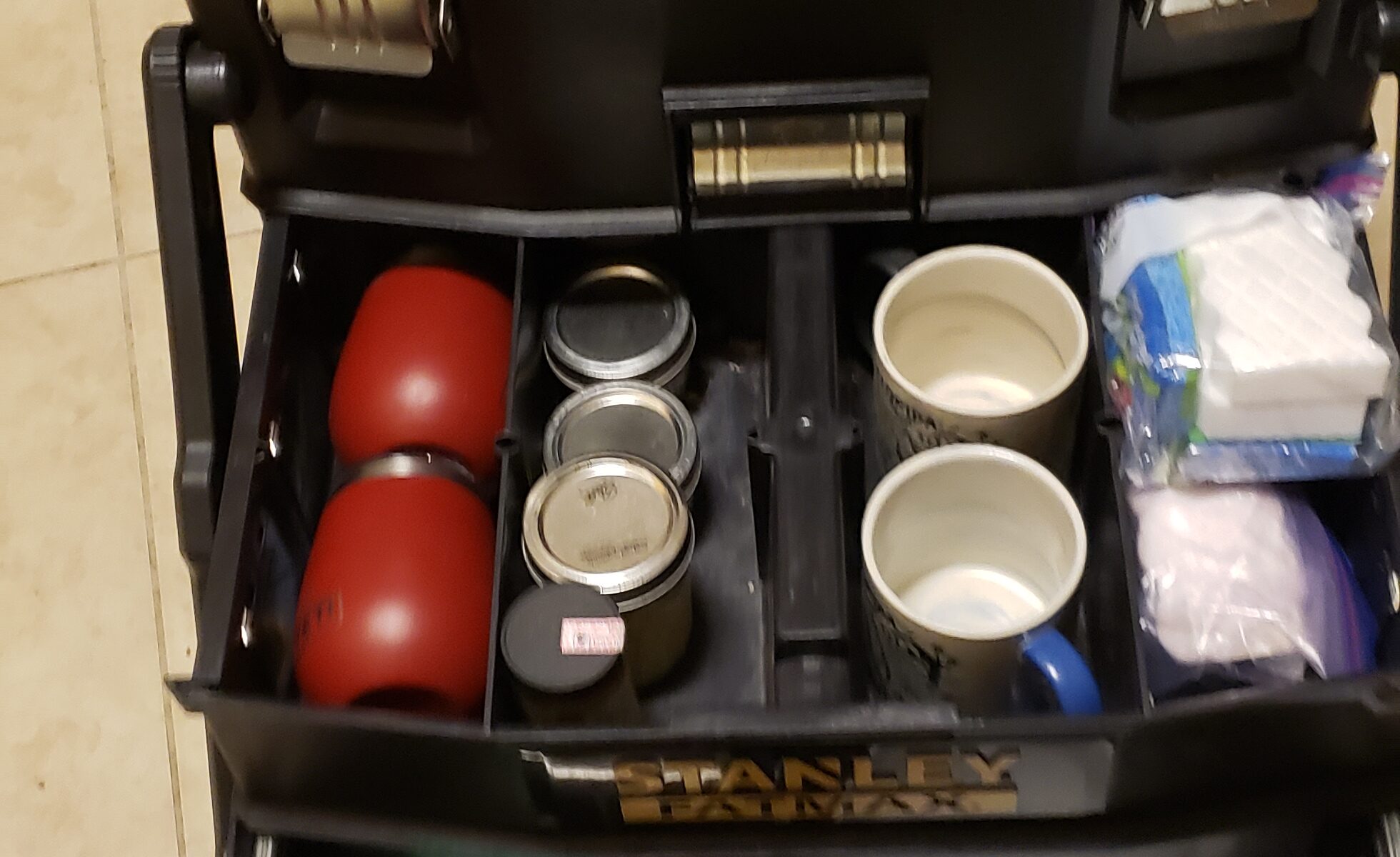When we left for Silver Springs, rain was in the forecast every day, so we did not take kayaks. As it turned out, rain was not a major issue on this trip. Without kayaks to enjoy the river, we spent much of our trip enjoying the trails and each other.
Continue reading “Camping at Silver Springs State Park”WWW – 07.14.2021

Five Florida Trips I’d Love to Make
The hottest part of summer has settled in, and I really don’t want to be outside too much. Instead, I’m daydreaming about the return of more temperate weather. I have about four months to think about what I want to do when it is pleasant to be outside again. There’s something fun to do in every single county, and some things need doing more than once.
Lessons Learned
Since the start of the pandemic, I’ve camped more than I have in the previous five years, and that trend will continue. But in this same time, I’ve learned some things about what sacrifices I’m just not willing to make. I understand that camping involves living without all the modern conveniences, and that’s fine.
But look, I consider running water a necessity. I need a hot shower at the end of the day and I want to wash my dishes in a sink. I want enough electricity to charge my phone at night because I use it as my camera. Good old Mr. Coffee is the best way to make coffee in the morning. And you know, a flush toilet is a lovely thing. So, unless we buy an RV, I’ll be sticking to campsites with electric and water on-site.
Now that we have THAT settled, here are the five trips I’m daydreaming about.
1. Fort Clinch in Northeast Florida
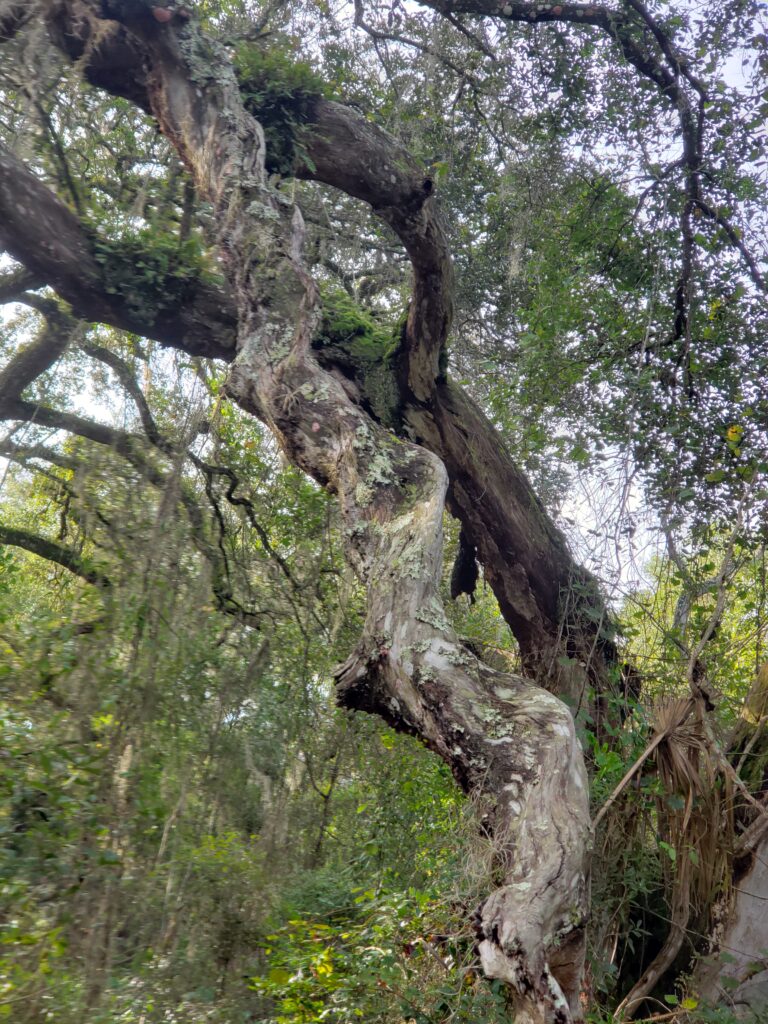
As soon as the evening temperatures are in the low 70s and the humidity is bearable, I’d love to camp at Fort Clinch State Park (https://www.floridastateparks.org/fortclinch), right at the Florida-Georgia state line. With both river and ocean camping loops, it might be worth spending a whole week to make sure we see everything worth seeing. The park is filled with history and hiking trails and there are shark’s teeth on the beach…I think this would be a great spot to spend some time in September or October.
2. Lake Louisa in Central Florida
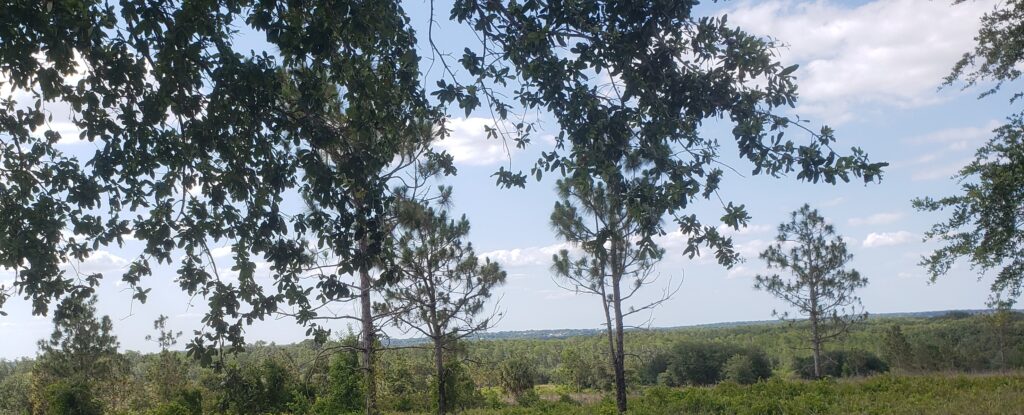
Steve and I have made several day trips to Lake Louisa. We’ve taken kayaking classes on the beautiful lakes and we’ve admired the many native plants that grow here (and have toured some reclamation and rescue areas with the rangers). It is a beautiful park at the north end of the Lake Wales Ridge. The one thing we’ve never done here is stargaze, and I believe I’d love to see the night sky here. I’ve been in the cabins, and they are beautiful – as with all Florida state park cabins, they have two bedrooms, full kitchens, and no television. Heaven!
3. Kissimmee Prairie in South Central Florida
I’m a Florida girl through and through and waking up to see frost at Kissimmee Prairie was a shock to my system. But I can’t get the thought of that magnificent prairie out of my mind, and I’d love to plan a trip during a meteor shower because this is a designated dark sky site.
The first time we camped here, we were impressed with the trails. We camped on an interior site (next time we’ll try for a site open to the prairie) and enjoyed our morning campfires while we waited for the sun to warm things us. I wouldn’t mind another cold weather camping trip here…it made the hiking super enjoyable and the days were warm enough that we could enjoy sitting in camp reading or playing games.
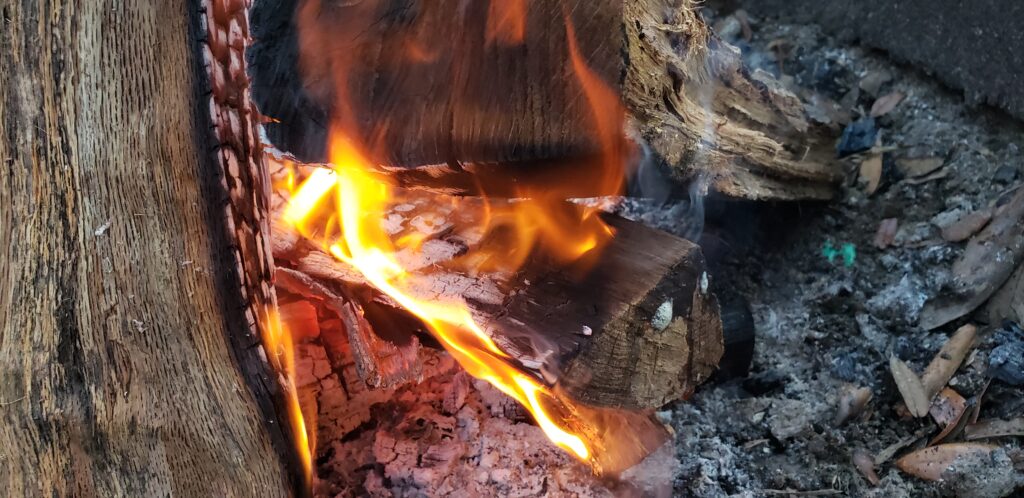
4. Everglades and 10,000 Islands
I want to camp at Collier Seminole State Park anytime I can, and thoroughly explore the Everglades and 10,000 Islands. I’d love to return to Delnor Wiggins Pass, too, and spend another day at the beach. When I camp there again, I will be sure to do a “wet hike” through the Fackahatchee Strand. I think this might be the most exciting area of Florida.
If I ever leave Central Florida, this is the area I’d love to investigate as a new home. Naples, which is congested and very expensive, is not at the top of my list, but I’d maybe look around Ochopee. I know, I know…it is soooo hot there so much of the year. But those swamps make my heart so happy!
5. Camping Across the Panhandle
I want to camp my way across the Panhandle from West to East, starting at Perdido Key/Big Lagoon and ending as close to Cedar Key as possible. Two or three nights at each site, maybe over a two- or three-week time period. This would be a lovely trip for late spring, when there are orchids all over the dang place at Tarkiln Bayou and pitcher plants are blooming in the Apalachicola National Forest. Is this part of the state more exciting than southwest Florida? I honestly don’t know. Perhaps a back-to-back trip is in order to compare the two.
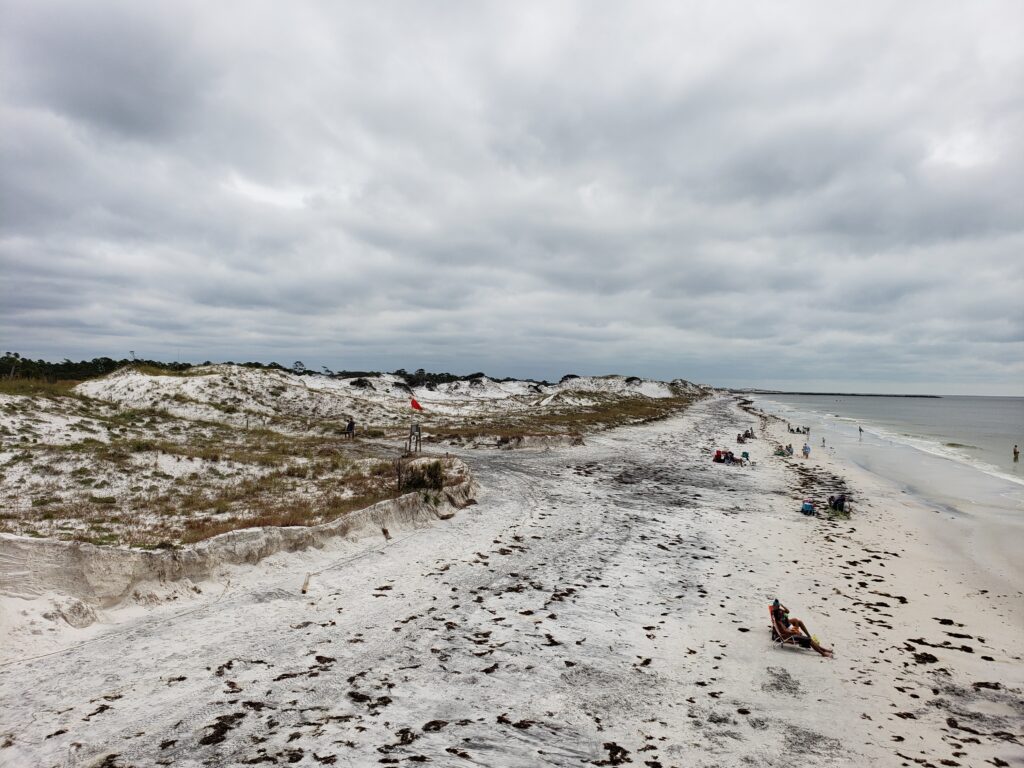
In the meantime, I’m going to be enjoying the pool and planning some new camping menus. How do you get through the long, hot summer?
WWW – 07.07.2021
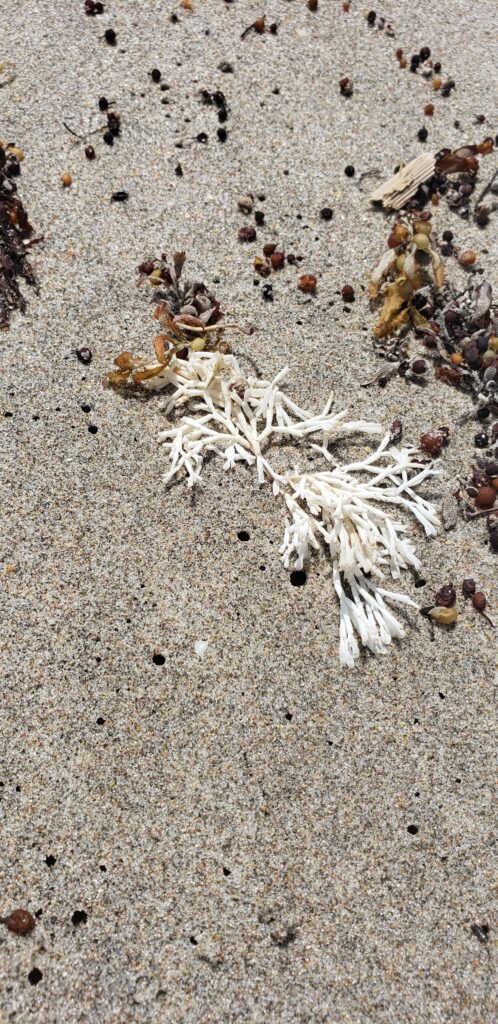
Hiking Sweetwater Preserve
I was surprised at how much there was to see on the two short loop trails that traverse Sweetwater Preserve. The preserve encompasses 125 acres of watershed along both sides of Sweetwater Branch Creek, a waterway that flows out of downtown Gainesville.
The Creek
If you look at a map of Sweetwater Branch, it is obvious that the natural water flow has been changed so that the creek now flows in very straight lines. Because of this and the fact that the creek flows through areas that were once landfills, Sweetwater Wetland Park has been developed to treat this very dirty surface water using natural processes — Sweetwater Preserve is just upstream from Sweetwater Wetland Park. This improved water eventually flows into Paynes Prairie, where it is further filtered by many plants before it enters the Floridan aquifer.

When you look at maps for these trails, you will notice two distinct loops: the East Loop and the West Loop. We started at the West Loop, parking at the end of SE 16th Avenue. There is not a parking lot and there are no restrooms here. The trailhead is clearly marked, though, and it was shady. It was very hot, so the shade was welcome.
West Loop
The West loop was, to my way of thinking, a hot mess. The trail was not clearly marked and appeared to cross over itself many times. The only part I felt confident about was the northeast part of the trail that closely followed Sweetwater Branch Creek. But the creek was beautiful (in spite of being terribly polluted by its travels through former landfills) and looked like a spring run, the plants were beautiful and the light filtering through the trees was relaxing, so I’d come back if given the chance. If you go, watch out for poison ivy…it’s everywhere on this loop.

A very nice footbridge crosses the creek and joins the West loop to the East. And, oh, that East loop!
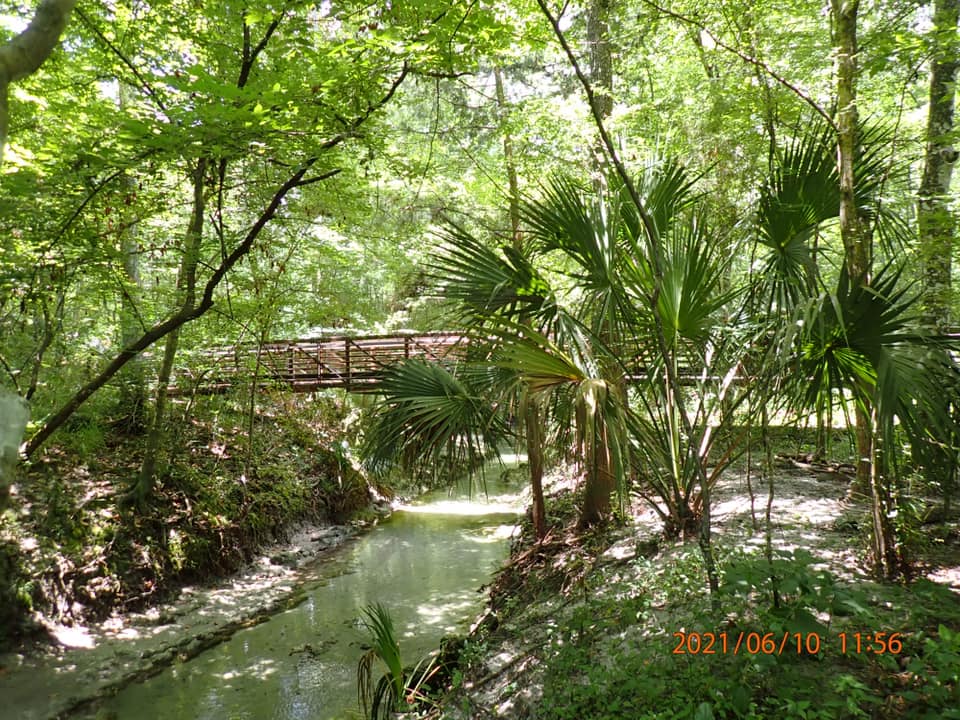
East Loop
The trail on the East loop is very well marked, and the numbered posts matched the map we had found online. We stopped at the sinkhole pond to cool off and enjoy a short break. While there, we admired the googley eyes someone has placed on the informational kiosk. There are not many kiosks that cannot be improved by the judicious application of googley eyes. We listened to a bullfrog calling for friends, adjusted our packs, and walked on.
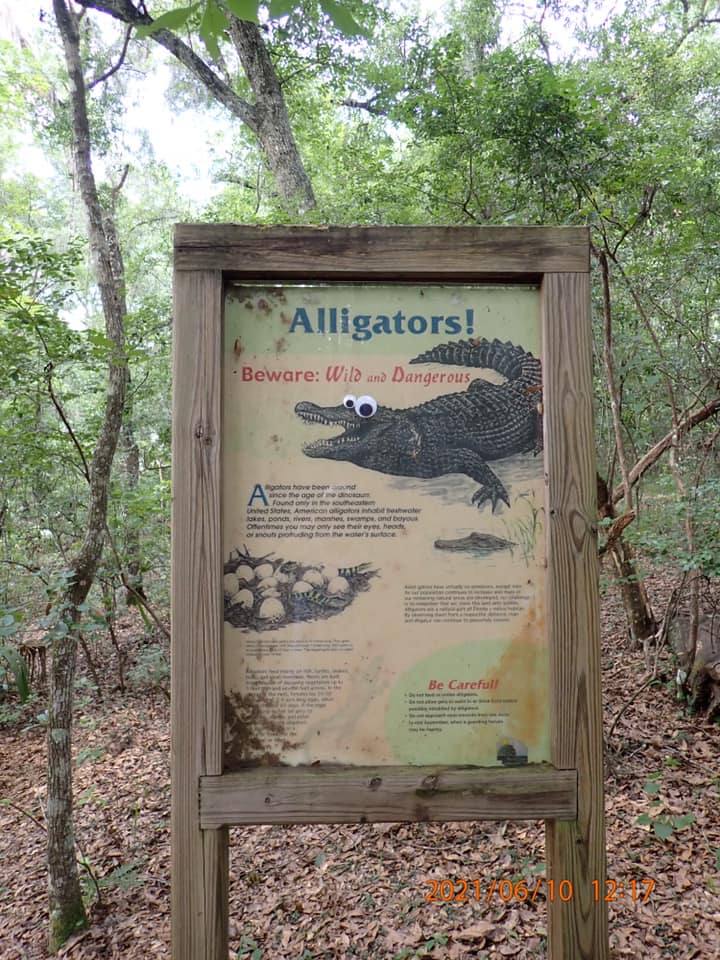
The trail feels longer than the listed 1.2 miles, and travels through numerous habitats, including sandhill, hammocks, the sinkhole lake, baygall (shallow wetlands), seepage stream, upland and floodplain forests, and mesic flatwoods.
Way Down Yonder in the Pawpaw Patch
It was along this trail that I finally got to see a pawpaw that was bearing fruit. My family used to sing a little song about pawpaws, and so ever since I was a little girl, I’ve wanted to see a pawpaw. I’ve managed to find the plants, and I frequently see them blooming in the spring, but this was the first time I’ve seen the fruit. They were not ripe, but I broke one open to see the inside. It looks like they would be pulpy with large seeds. Maybe I can go back and find out!
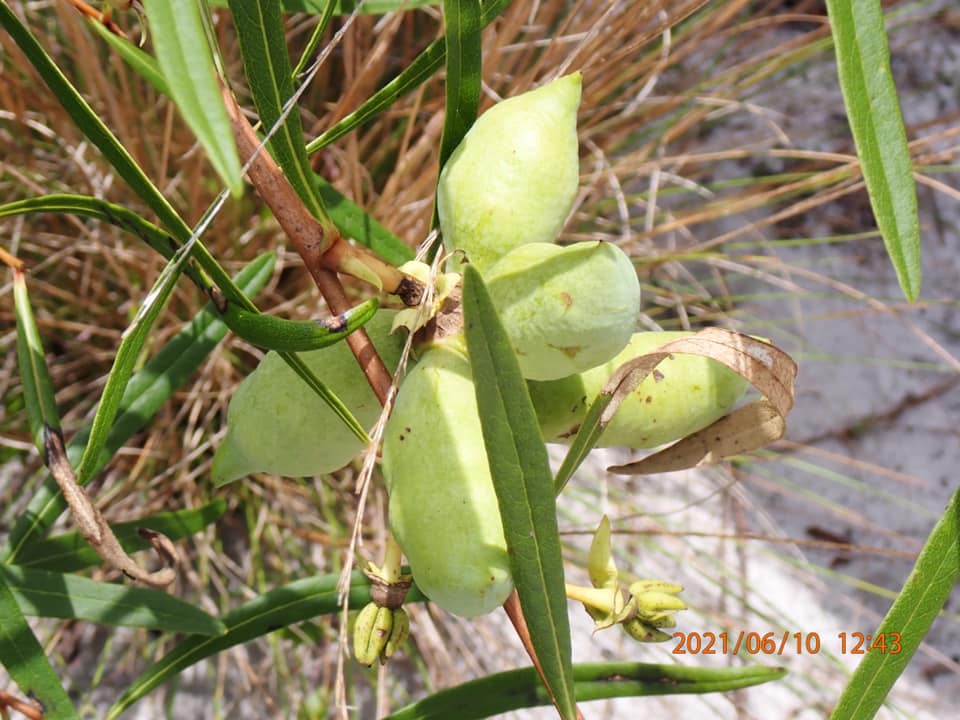
Once water from this preserve leaves on the downstream flow, it enters Sweetwater Wetlands Park. In this park, the sheetwater flow of Sweetwater Branch is being restored to a more natural state. As it flows across the park, it is also cleaned up before it hits Paynes Prairie. I hope to see this park next time I’m in the area. Maybe it will be as impressive as Orlando Wetlands Park. These projects create not only cleaner water, but opportunities for all of us to appreciate how resilient nature can be if we get out of the way.

WWW – 06.30.2021
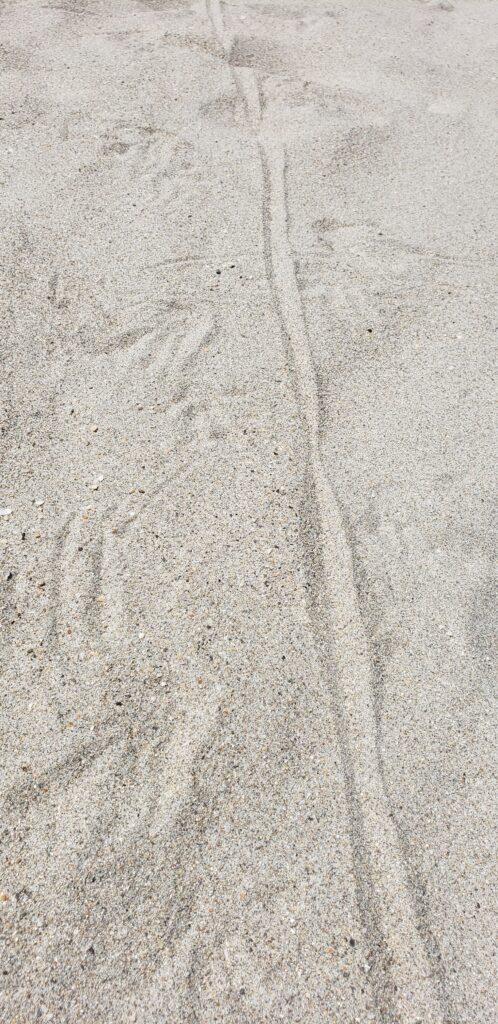
Paynes Prairie Preserve State Park
My buddy Judy celebrated her birthday last week. To celebrate, we made the short trip to Gainesville to camp at Payne’s Prairie. We took back roads and avoided I-75, so we were already relaxing by the time we got to Payne’s Prairie State Park.
Florida is HOT in June!
First, let me just say that tent camping in Florida in June is only for the courageous. It is hard to say which was more troublesome: mosquitoes or deerflies. But I can promise that the heat was ridiculous. It was hard to fall asleep even after a relaxing shower and staying hydrated was a challenge given that we were sweating our brains out. BUT – if you must tent camp in June, Payne’s Prairie is a pleasant place to do so.
Our Campsite

Payne’s Prairie tent-only sites do not all have power and water. Check before reserving if that’s important to you. Water is available at the bathhouse, of course, but water is heavy and you may not want to carry it. Our camping loop comprised three tent sites – 27, 28, and 29. To get to site 27, you had to walk through 28, but our site, 29, offered superb privacy. We used water from site 27 since no one was camping there.
Surprisingly, there appear to be NO raccoons in this park! I don’t think I’ve ever tent camped in Florida without being awakened by rummaging raccoons. Our site provided a picnic table and a tall post with a hanging hook where a lantern could be hung. There is some road noise from I-75, but it was nearly inaudible over the cicadas and tree frogs.
The Visitor Center
The visitor center is staffed by knowledgeable volunteers and overlooks the prairie. You’ll have the opportunity to watch an overview movie that lasts about 20 minutes – we were eager to get on to the trail and did not watch the movie. We did, though, enjoy the other displays. From the large window, we could see bison in the distance!
Observation Tower and a Bit of Advice
From the visitor center, it is just a short walk to the three-level observation tower, and it is worth climbing to the top for a beautiful view of the prairie. My best advice for viewing the prairie is to give it time. This is not a sight like the Grand Canyon or a coral reef – you can easily be deceived into thinking there is nothing to see. But the longer you watch the prairie, the more there is to see, and you could overlook something wonderful by not giving this place time to unfold before your eyes.

Karst Geology and Alachua Sink
Up on the tower, you get a sense of how vast the prairie is, and how Florida’s karst geology informs its landscape. This prairie was formed as sinkholes merged. As often happens in Florida where water and plants are left to work together naturally, the plants form a filter to purify the water. The amount of life nourished by this system is unimaginable. Bear, deer, smaller mammals, waterbirds of every kind, alligators and smaller reptiles, fish, plants. . .it’s all here.
At the end of the 19th Century, Alachua Sink (the major drain of the Prairie) got blocked and the prairie was covered by a large lake. During the two-decade blockage, ferryboats used the lake to travel from Gainesville to Micanopy (pronounced mih-ka-NOPE-ee) and fishermen were delighted. Imagine their disappointment in 1891 when the blockage disappeared, taking the lake with it!
Lake Wauberg
Part of the Lake Wauberg lakeshore is accessible from within the state park. There are lovely places to sit and enjoy the lake, a boat launch for boaters and kayakers, and you can even fish if you are properly licensed. The lakefront is a really nice place to sit in the late afternoon and enjoy something cold to drink and you cool off from the heat of the day.

Hiking
If you like hiking, there are trails for every skill level at Payne’s Prairie and in the immediate area. A large wall in the visitor center provides information about the length of each trail and what you may see on each one. I would have liked to see better trail information, especially since there was no guidance once actually on the trail. When we go back for more hiking, we will bring our own maps. We hiked more at Sweetwater Preserve than we did at Payne’s Prairie, mostly because Sweetwater was shaded.
When you hike at Payne’s Prairie, be prepared with plenty of sunscreen and water. We had been warned to bring insect repellent but did not find it necessary on Cones Dike Trail, which led us straight along the edge of the prairie. Plentiful waterbirds were in evidence, along with lizards, a doe and her fawn. . .but no buffalo or wild horses.

We have both decided that we’d love to come back to camp here again, but only during cooler weather. The primitive camping conditions (no water/power onsite) just made the heat a bit too much for us to bear. With a regular afternoon rainstorm, it might have been cool enough to stay in tents, but we got no rain while we were there. In the air-conditioned popup or an RV summer camping would be bearable on sites with power and water.

WWW – 6.23.2021
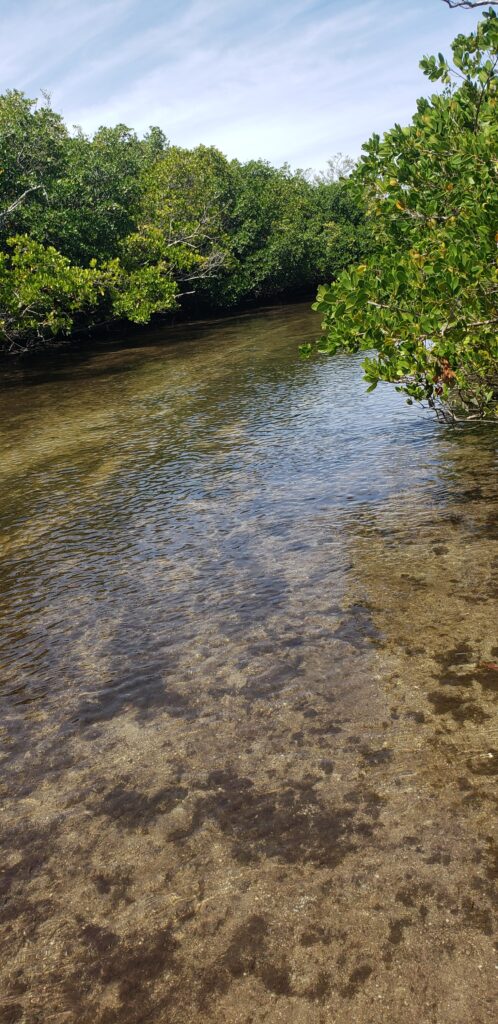
10 Must-Haves for a Camping Kitchen
My camping style falls somewhere in between bare bones and glamping, but I do love to eat, and a great dinner is one place where I won’t cut corners. Over a lifetime of camping, I’ve managed to whittle my kitchen down to a manageable size so it can be transported easily, whether I’m camping with my hubby in the pop up or camping on my own in my tent.
Full disclosure is necessary, though. I prepare most of our meals at home, freeze them, and thaw and reheat at camp. We usually have fresh salads (I chop the veggies at home). This cuts down on the equipment I need and the time I spend prepping at camp. I would much rather do my chopping and peeling in an air-conditioned kitchen!
1. Pots and Pans
I have two pots and two skillets, in different sizes. So far, I have not missed other sizes and containers in my camping life! My skillets are stainless, not cast iron, and some people are surprised and even scandalized by this. You do you: if you want cast iron, pack it! I love my lightweight stainless and have not missed the cast iron since I gave it up years ago. I have a lid for the smaller of the two pots, but I think I will add one for the larger pot, too.
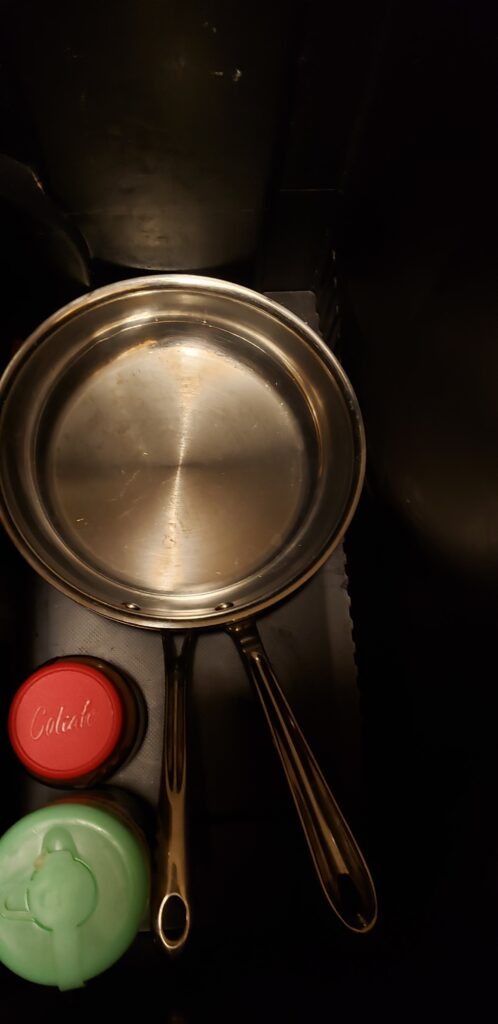
2. Plates and Cutlery
I have a couple of large ceramic bowls, a few melamine plates, and real cutlery that I store in a rack that goes on the table. The rack includes steak knives, a small set of tongs, and a serving spoon and serving spatula. I have two coffee mugs because, honestly, what good is waking up in paradise if you can’t enjoy the sunrise with a great cup of coffee? I’ve also got two stemless wine goblets because, honestly, what good is winding down in paradise if you can’t enjoy the sunset with a nice sangria?



3. Cooking Implements
Here, too, my kitchen is fairly stripped down. I have a good can opener, which I’m considering ditching now that many canned goods have pull tops. I’ve got a stainless spatula and a big stainless cooking spoon. I don’t have a strainer. I don’t have fancy gadgets, but I do have a French press coffee pot for when I travel on my own. When Steve and I camp together, we bring Mr. Coffee along. I also filter camp water, so we have 2 Brita pitchers. On my St. Augustine trip, I bought a stainless steel bowl for salads.
4. Pantry Items
My kitchen box is large enough to hold some pantry items. I store it in the shed, so humidity is an issue. But I permanently store artificial sweetener, Brita filters, multiple lighters and some fire starter material (along with spark-makers so the fire will start even if all the lighters are empty!), some seasonings, tea bags, and packets of hot chocolate. I’ve got a 2 quart pitcher for iced tea and a stainless steel French press coffeepot. I might throw in a couple packages of ramen noodles as I pack for a specific trip, and of course, I add salt and pepper.
5. Coleman Stove
Since I was a child, I’ve cooked on a Coleman stove, and I don’t think you can do better for most camping meals. I did make the switch from white fuel to propane, and I find it heats very quickly and is very convenient. It starts every time and I think I own three of them. Why? Because I can.
6. Miscellaneous Items
I ALWAYS use a tablecloth when camping. I’ve seen RVers put their waste hoses on picnic tables…ugh. So I have multiple tablecloths. I use Dr. Bronner’s Peppermint Soap for everything, so you’ll always find that in my camp kitchen. I’ve also got hot pads and trivets, paper towels, disinfectant wipes, and a wipe container filled with grocery store bags that we use as trash bags. We produce little trash when we camp, and a single grocery store bag gets us through the entire day.
7. Okay — NOT Kitchen Items but Still Gotta Have Them!
Hmm. I didn’t make it to ten. So I’ll share with you a few more things I love to bring along. We recently treated ourselves to two sets of solar camp lights. They look like the Edison bulbs, and a single string is long enough to go around our 10X10 canopy. I absolutely LOVE everything about these lights. They are convenient, easy to set up, STURDY, and provide enough light to read by without keeping neighboring campers awake. In all honesty, we are usually asleep soon after dark, but we love these lights!
8. Games.
We have SO MANY GAMES, but we always bring Itzi, Pairzi, and Tenzi when we camp. Cards, too. And when I finally master Cribbage, we’ll add a Cribbage board to our must-haves. We get our games here.
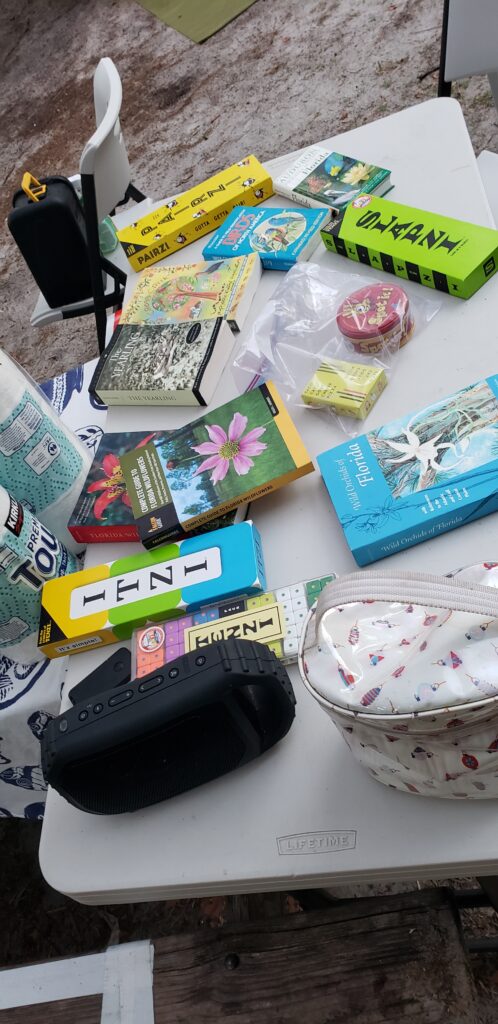
9. Small Vacuum Cleaner
Nope, I’m not kidding. I cannot stand sand and dirt all over my tent or in the pop up, and I invested in a small vacuum that keeps my feet happy. It’s rechargeable and has a light so I can see the sand. I love it!
10. Door mat/Ground Cover
To reduce the need for the vacuum, I also bring a door mat and ground cover. These go, of course, right outside the tent or pop up. They don’t stop ALL the dirt, but they stop most of it.
There are things I want to add, like a handwashing sink and maybe an electric kettle for late night cups of tea. But for now, this kitchen set-up helps me stay organized and avoid single use plastics. Other than the paper towels and wipes, it’s an environmentally friendly kitchen. I’m not a recycling nazi, but I do want to be responsible.
Now it’s your turn. What are your must-haves? What might make this a better set-up?
WWW – 06.16.2021
